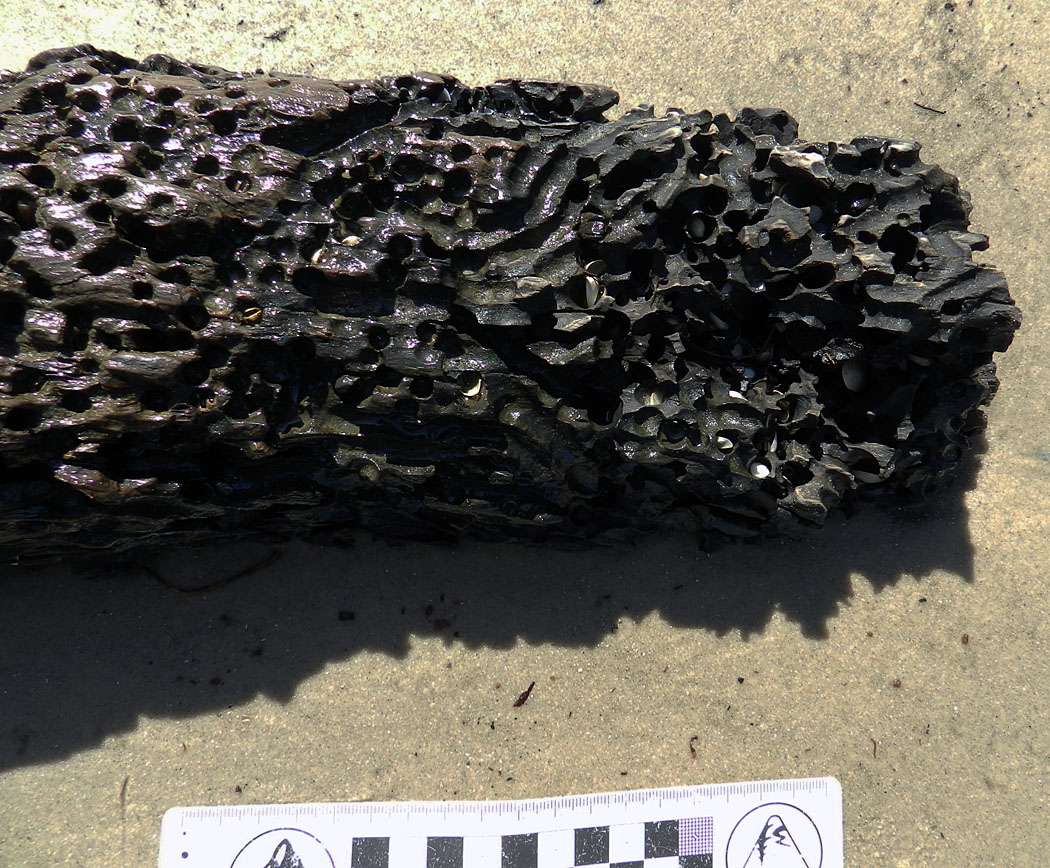Today’s photo of Georgia-coast traces – similar to yesterday’s about sea turtles connecting to the land through their traces – shows how other marine animals depend on landward environments of the Georgia barrier islands for their livelihoods. In this instance, marine clams require trees to give them homes, and these clams leave marks of their dependency for us to see on formerly forest flotsam that made its way back to land.
 A piece of driftwood rendered holey by abundant and active wood-drilling marine bivalves, some of which also left their bodies in their former homes. These borings are probably all the work of wedge piddocks (Martesia cuneiformis), which settled onto the wood as wee little clams (larvae, actually), then started drilling.(Photograph by Anthony Martin, taken on Jekyll Island, Georgia.)
A piece of driftwood rendered holey by abundant and active wood-drilling marine bivalves, some of which also left their bodies in their former homes. These borings are probably all the work of wedge piddocks (Martesia cuneiformis), which settled onto the wood as wee little clams (larvae, actually), then started drilling.(Photograph by Anthony Martin, taken on Jekyll Island, Georgia.)
After the larvae of these clams latched onto these woody substrates – whether these were floating on ocean currents or sunken on sea bottoms – they then lived out their lives drilling into the wood. They drill into wood by rotating or otherwise moving their ridged shells against the hard substrate, like a self-propelled screw.
A few species of wood-drilling clams – sometimes nicknamed “shipworms,” despite their molluscan heritage – actually eat the wood for food. But others, including wedge piddocks, are just making tight, secure homes, similar to how some animals make snug burrows for themselves. Once in a while we get to see the handiwork of these clams in pieces of wood that wash up on Georgia shorelines, a special delivery brought to us by tides and waves.
Wood-boring clams probably evolved about 150-200 million years ago during the Mesozoic Era, and their trace fossils are common in fossil driftwood from the Jurassic Period to just recently. For marine clams to start drilling into wood – whether for food, homes, or both – is pretty remarkable as a behavior, when you think about it evolving in response to the growth of forests on land. After all, bivalves lived in the world’s oceanscapes long before forests spread across landscapes, with the former starting in the Cambrian Period (more than 500 million years ago) and the latter starting in the Devonian Period (about 350 million years ago).
But it’s also interesting to think about how marine clams apparently did not take advantage of these terrestrial tissues for several hundred million years after wood first started floated out to sea. In contrast, mites, insects, and other land-dwelling invertebrates began chewing wood right away, and consequently left their own distinctive traces (mentioned last week with beetle borings). But thanks to trace fossils, we can better tell when terrestrial animals commenced wood-eating behaviors, and when certain marine clams began mixing their traces with those of their land-lubbing compatriots.
Further Reading
Martesia cuneiformis (Say, 1822) Wedge Piddock. Jaxshells.org, by Bill Frank, images by Joel Wooster.
The Second World That Forms on Sunken Trees. Ed Yong, Not Exactly Rocket Science, National Geographic Phenomena.
Wood: It’s What’s For Dinner. Craig McClain, Deep Sea News.
Links to Previous Posts in This Theme
On the 12th Day of Ichnology, My Island Gave to Me: 12 Snails Grazing
On the 11th Day of Ichnology, My Island Gave to Me: 11 Plovers Probing
On the 10th Day of Ichnology, My Island Gave to Me: 10 Beetles Boring
On the 9th Day of Ichnology, My Island Gave to Me: 9 Molluscans Hiding
On the 8th Day of Ichnology, My Island Gave to Me: 8 Crab Legs Walking
On the 7th Day of Ichnology, My Island Gave to Me: 7 Lizards Looping
On the 6th Day of Ichnology, My Island Gave to Me: 6 Hatchlings Crawling
